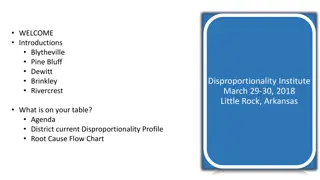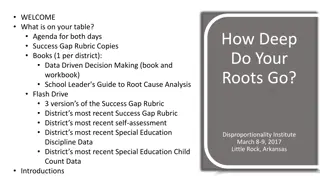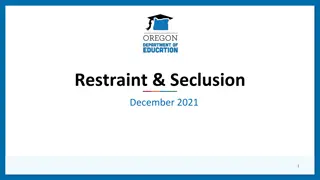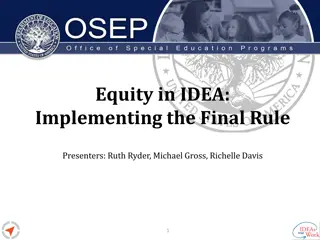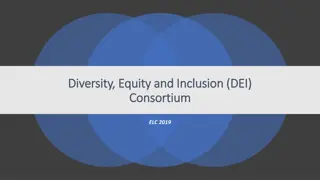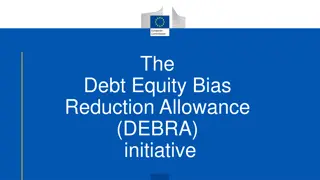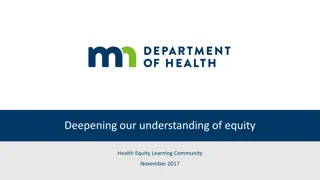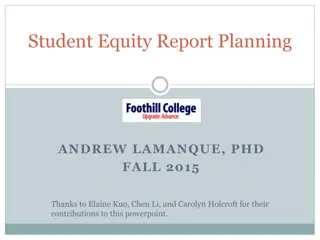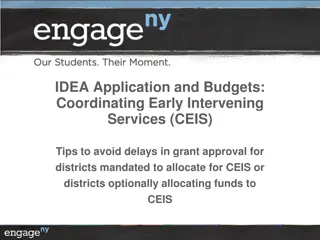Promoting Equity in Education: Addressing Significant Disproportionality
In the pursuit of educational equity, we must address significant disproportionality that affects students of color, English learners, and those from underserved backgrounds. This involves recognizing the root causes of academic challenges and creating inclusive, culturally responsive learning environments. Our goal is to ensure all students have access to resources and opportunities needed for cognitive and social-emotional growth, aiming to eliminate disparities and cultivate individual strengths. Working towards equity means removing biases, fostering inclusivity, and striving for equally high outcomes for every learner.
- Equity in Education
- Disproportionality
- Inclusive Learning Environments
- Educational Equity
- Culturally Responsive Teaching
Download Presentation

Please find below an Image/Link to download the presentation.
The content on the website is provided AS IS for your information and personal use only. It may not be sold, licensed, or shared on other websites without obtaining consent from the author. Download presentation by click this link. If you encounter any issues during the download, it is possible that the publisher has removed the file from their server.
E N D
Presentation Transcript
Significant Disproportionality Basics December 7, 2021
Contents 01 Welcome and Introduction 02 What is Significant Disproportionality? How is it Calculated? 03 CONTENTS Developing an Action Plan 04 05 What s Next? Questions 06
01 Welcome and Introduction
Purpose of this Work In recent years, there s been a lot of talk about the reasons behind the low performance of many students of color, English learners, and poor students. Rather than examine school policies and teacher practices, some attribute it to a culture of poverty or different community values toward education. The reality is that they struggle not because of their race, language, or poverty. They struggle because we don t offer them sufficient opportunities in the classroom to develop the cognitive skills and habits of mind that would prepare them to take on more advanced academic tasks (Jackson, 2011; Boykin and Noguera, 2011). That s the achievement gap in action. (p. 14). Culturally Responsive Teaching and the Brain, Zaretta Hammond 4 Massachusetts Department of Elementary and Secondary Education
Our Goal: Equity for All Students Equity: Educational equity means that all students have access to the educational resources, opportunities, and rigor they need at the right moment in their education across race, gender, ethnicity, language, disability, sexual orientation, family background and/or family income to meet high expectations for cognitive, behavioral, and social- emotional growth and development. Adapted from Leading for Equity: Opportunities for State Education Chiefs, https://ccsso.org/equity and National Equity project, http://nationalequityproject.org/about/equity MA DESE District Standards and Indicators, http://www.doe.mass.edu/accountability/district-review/district- standards-indicators.pdf#search=%22district%20standards%20indicators%22 5 Massachusetts Department of Elementary and Secondary Education
Working Toward Equity Involves Ensuring equally high outcomes for all participants in our educational system; removing the predictability of success or failures that currently correlates with any social or cultural factor Interrupting inequitable practices, examining biases, and creating inclusive multicultural school environments for adults and children Discovering and cultivating the unique gifts, talents and interests that every human possesses. National Equity Project, Why Equity? https://nationalequityproject.org/about/equity 6 Massachusetts Department of Elementary and Secondary Education
02 What Is Significant Disproportionality?
Overview of IDEA Equity Calculations States have distinct equity requirements under various sections of IDEA. Significant Disproportionality in Identification, Placement, and Discipline Significant Discrepancy in Discipline (SPP/APR Indicators 4A & 4B) Disproportionate Representation (SPP/APR Indicators 9 & 10) 8 Massachusetts Department of Elementary and Secondary Education
IDEA and Disproportionality IDEA requires that states determine disproportionality in respect to: oidentification of children as children with disabilities and in six specific disability categories oplacement in particular educational settings of such children odisciplinary actions including the incidence, duration, and type, includes both suspensions and expulsions. 9 Massachusetts Department of Elementary and Secondary Education Source: https://sites.ed.gov/idea/files/significant-disproportionality-qa-03-08-17.pdf
Why are we addressing significant disproportionality? we need to address racial and ethnic disparities in special education. This important step forward is about ensuring the right services get to the right students in the right way. Former US Secretary of Education John B. King Jr. Source: https://www.ed.gov/news/press-releases/fact-sheet-equity-idea 1.7X 1.9X African American students with disabilities in MA are 1.7 times as likely to receive a disciplinary removal than all other students with disabilities Hispanic students in MA are 1.94 times as likely to be identified as a student with an Intellectual Disability than students in other racial/ethnic groups 10 Massachusetts Department of Elementary and Secondary Education
Identification as SwIEPs by Student Group (SY 2020-21) 100 90 80 70 76.3 78.6 78.7 60 81.3 50 40 30 20 23.7 21.4 21.3 10 18.7 0 All Students African American/Black Students Hispanic/Latino Males % Students with IEPs % Students without IEPs 11 Massachusetts Department of Elementary and Secondary Education
Comparing Identification of SwIEPs by Student Group (SY 2020-21) 70 65.2 60 48.4 50 40 30 25.4 21.6 20 10.7 9 10 0 African American/Black Hispanic/Latino Males Students with IEPs % Students without IEPs % 12 Massachusetts Department of Elementary and Secondary Education
Graduation Rates for Students with IEPs 13 Massachusetts Department of Elementary and Secondary Education
Discipline Rates: 2016-2018 School Year 2017-2018 School Year 2018-2019 School Year 2019-2020 Percent Disciplined Percent Disciplined Percent Disciplined Total Enrolled Total Disciplined Total Enrolled Total Disciplined Total Enrolled Total Disciplined All Students 981,288 40,809 4.16% 976,789 41,501 4.25% 970,032 28,332 2.92% Students with Disabilities 184,566 14,560 7.89% 187,717 14,657 7.81% 184,561 10,492 5.68% 14 Massachusetts Department of Elementary and Secondary Education
03 How is it Calculated?
DESE must calculate disproportionality with respect to The identification of children ages 3 through 21, as children with : 1. A disability 2. An intellectual disability 3. A specific learning disability 4. Emotional disturbance 5. Speech or language impairments 6. Other health impairments 7. Autism Identification Placements of children with disabilities ages 6 through 21: 8. Inside a regular class less than 40% of the day 9. Inside separate schools and residential facilities Discipline incidents, including, for children with disabilities ages 3 through 21: 10. Out-of-school suspensions and expulsions of 10 days or fewer 11. Out-of-school suspensions and expulsions of more than 10 days 12. In-school suspensions of 10 days or fewer 13. In-school suspensions of more than 10 days 14 . Disciplinary removals in total Placement Discipline 16 Massachusetts Department of Elementary and Secondary Education
Risk Ratio and Alternate Risk Ratio Risk ratio o comparison between the likelihood that students in a particular racial/ethnic group within an LEA will experience a specific outcome (identification, placement, or discipline), compared to the likelihood that students in all other racial/ethnic groups with an LEA will experience the same outcome Alternate risk ratio o Used if comparison group is too small o comparison between the likelihood that students in a particular racial/ethnic group within an LEA will experience a specific outcome (identification, placement, or discipline), compared to the likelihood that students in all other racial/ethnic groups across the state will experience the same outcome 17 Massachusetts Department of Elementary and Secondary Education
For each of these categories, states must calculate a RISK RATIO. RISK RATIO Example: 80 African American children identified 400 total African American children in LEA _______________________________________________________________________ 200 non-African American children identified 2,000 total non-African American children in LEA Risk ratio: 2.0 (80/400) / (200/2000) = 0.2 / 0.1 = 2.0 African American students in district A are 2.0 times as likely to be identified as a student with a disability, compared to students in all other racial and ethnic groups in the district. 18 Massachusetts Department of Elementary and Secondary Education
For districts where the comparison group is small, states must use an ALTERNATE RISK RATIO. ALTERNATE RISK RATIO Example: 80 African American children identified 400 total African American children in LEA _______________________________________________________________________ 150,000 non-African American children identified across the state 900,000 non-African American children across the state Risk ratio: 1.2 (80/400) / (150,000/900,000) = 0.2 / 0.17 = 1.2 African American students in district B are 1.2 times as likely to be identified as a student with a disability, compared to students in all other racial and ethnic groups across the state. 19 Massachusetts Department of Elementary and Secondary Education
Timeline SY17-18 SY18-19 SY19-20 SY20-21 SY21-22 SY22-23 Placement and Identification Data Year 1 Placement and Identification Data Year 2 SY 21- 22 Identified LEAs reserve 15% of Part B Funds for CCEIS DESE identifies LEAs with significant disproportionality and those at-risk for future identification and supports these districts Placement and Identification Data Year 3 Discipline Data Year 2 Discipline Data Year 3 Discipline Data Year 1 SY20- 21 Identified LEAs reserve 15% of Part B Funds for CCEIS in FY21 Fund Code 240 20 Massachusetts Department of Elementary and Secondary Education
Identification of Disproportionality States have flexibility to set: oMinimum cell size and n size oNumber of years of historical data oRisk ratio threshold oDefinition of reasonable progress 21 Massachusetts Department of Elementary and Secondary Education
Cell Size and N-Size We will only calculate a risk ratio for groups that meet the minimum cell size (6) and n-size (20). oCell size: Number of children in the racial/ethnic group(s) experiencing a particular outcome. Numerator in the risk calculation. oN-size: Number of children in the racial/ethnic group(s) enrolled in a district with respect to identification, and the number of children with disabilities enrolled in an LEA with respect to placement and discipline. Denominator in the risk calculation. 22 Massachusetts Department of Elementary and Secondary Education
Risk Ratio and Reasonable Progress The risk ratio threshold in Massachusetts is 3.0 If the district is making reasonable progress, a state is not required to make an identification of significant disproportionality o Reasonable progress: lowering the risk ratio or alternate risk ratio for the group and category in each of the two prior consecutive years Year 1 Year 2 Year 3 Reasonable Progress District 1 5.6 5.3 5.2 Meets Reasonable Progress District 2 4.9 4.8 4.6 Meets Reasonable Progress District 3 4.7 4.9 4.3 Does Not Meet Reasonable Progress 1. https://sites.ed.gov/idea/regs/b/f/300.647/c 23 Massachusetts Department of Elementary and Secondary Education
04 Developing an Action Plan
Planning for Success Planning for Success (PfS) is an oinclusive, hands-on planning process, odesigned to build district and school capacity and coherence, and ocommunity understanding and support. Developed and refined since 2013 by use in, and feedback from, school districts across Massachusetts. Provides educators with a variety of tools, protocols, and facilitation tips to support planning. A flexible process easily customized to each district's or school's unique context and preferred timeline. 25 Massachusetts Department of Elementary and Secondary Education
The Planning for Success Process Analyze performance, educator evaluation, and community feedback data for trends and patterns Envision the future Backward design the improvement strategy from specific, desired student outcomes, researching effective practices Create Plan Connect educator goals and any other improvement efforts to the multi-year plan Leverage budget, grants, and resources in support of the plan Build community commitment to the plan Align Systems Create an annual action plan with progress and impact benchmarks Monitor and publicly report on progress Redesign the multi-year plan if necessary Implement 26 Massachusetts Department of Elementary and Secondary Education
Action Planning for Continuous Improvement PDSA Cycle: a vehicle for constant, continual improvement and innovation Roehm, H. A., & Castellano, J. F. (1997). The Deming view of a business. Quality Progress, 30(2), 39- 45. 27 Massachusetts Department of Elementary and Secondary Education 27
Significant Disproportionality Expectations At-Risk Districts Identified Districts Identify factors contributing to significant disproportionality Conduct a review of Policies, Practices, Procedures (PPP) and publicly report on revisions Create an action plan and submit to DESE Reserve 15% of IDEA funds for Comprehensive Coordinated Early Intervening Services (CCEIS) o Ages 3-21 o Students with or without disabilities Identify factors contributing to significant disproportionality Conduct a review of Policies, Practices, Procedures (PPP) Create an action plan 28 Massachusetts Department of Elementary and Secondary Education
Comprehensive Coordinated Early Intervening Services (CCEIS) CCEIS includes a board range of activities that may include professional development and educational and behavioral evaluations, services and supports o https://ideadata.org/sites/default/files/media/documents/2017- 09/idc_ceis_chart.pdf CCEIS must identify and address the factors contributing to significant disproportionality, among other identified factors: o a lack of access to scientifically based instruction; o economic, cultural, or linguistic barriers to appropriate identification or placement in particular educational settings; o inappropriate use of disciplinary removals; o lack of access to appropriate diagnostic screenings; and o differences in academic achievement levels. 34 CFR 300.646(d)(1) 29 Massachusetts Department of Elementary and Secondary Education
Which Students May Receive CCEIS Services? CCEIS may: oserve children from age three through grade 12, oserve children particularly, but not exclusively, in the group(s) that was significantly over-identified, oinclude children who are not currently identified as needing special education or related services but who need additional academic and behavioral supports to succeed in a general education environment; and children currently identified as needing special education or related services. Funds may be used primarily, but not exclusively, to support currently eligible students. 30 Massachusetts Department of Elementary and Secondary Education
Steps to Take: Responding to Significant Disproportionality 1. Learn about significant disproportionality and your district s data snapshot 2. Develop the approach your district will take to analyzing and addressing significant disproportionality 3. Analyze data for students currently impacted and conduct a root cause analysis to identify contributing factors 4. Review your district s Policies, Practices, and Procedures (PPP) and assess how disproportionality may be impacted by the way your district implements its PPPs 31 Massachusetts Department of Elementary and Secondary Education
Steps to Take: Responding to Significant Disproportionality 5. Synthesize results of root cause and PPP analyses and identify the work the district will do Identified Districts: Review Comprehensive Coordinated Early Intervention Services (CCEIS) and select services to use 6. Create an action plan for the strategic initiative(s) that will address contributing factors 7. Identified Districts: Revise the district budget 8. Identified Districts: Begin implementing the action plan, publicly posting PPP revisions and implementing CCEIS 32 Massachusetts Department of Elementary and Secondary Education
05 What s Next?
Support Available to Identified Districts Timeline Support IDC presentation: CCEIS 1:1 technical assistance meetings Professional Learning Community (PLC) sessions Equity in Special Education Professional Development Conference CCEIS presentation: December 9 TA Sessions1: December- January; TA Session 2: April Three PLC sessions o January o February o March Equity conference: March 10 34 Massachusetts Department of Elementary and Secondary Education
Support Available to At-Risk Districts Timeline Support Office hours oJanuary oMarch Three PLC sessions oJanuary oFebruary oMarch Equity conference: March 10th Office hours Professional Learning Community (PLC) sessions Equity in Special Education Professional Development Conference 35 Massachusetts Department of Elementary and Secondary Education
Three Professional Learning Community (PLC) Options Create a Significant Disproportionality Action Plan, for districts focused on identification and placement Create a Discipline-Focused Significant Disproportionality Action Plan, for districts focused on discipline Implementing a Significant Disproportionality Action Plan, for districts now implementing an action plan and CCEIS 36 Massachusetts Department of Elementary and Secondary Education
DESE Significant Disproportionality Resources DESE Significant Disproportionality Website: http://www.doe.mass.edu/sped/idea2004/sig-dispro/ Memorandum on Significant Disproportionality in Special Education: http://www.doe.mass.edu/sped/advisories/2019-0621dispro.docx Quick Reference Guides o What is Significant Disproportionality Quick Reference Guide http://www.doe.mass.edu/sped/idea2004/sig-dispro/qrg.docx o Significant Disproportionality Fiscal Implications Reference Guide http://www.doe.mass.edu/sped/idea2004/sig-dispro/fiscal-implications- qrg.docx 37 Massachusetts Department of Elementary and Secondary Education
06 Questions?
THANK YOU specialeducation@doe.mass.edu www.doe.mass.edu 75 Pleasant Street, Malden, MA 02148


